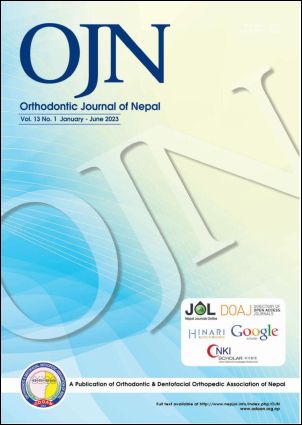The prevalence of malocclusions in patients seeking orthodontic treatment at COMS from Chitwan District of Nepal
DOI:
https://doi.org/10.3126/ojn.v13i1.53331Keywords:
Dental Health Component, Index of Orthodontic Treatment Need, malocclusion, PrevalenceAbstract
Background: Malocclusion is the abnormal relation between maxillary and mandibular teeth which leads to various problems like esthetics, phonation, mastication, psychological and social problems. The prevalence of malocclusion is highly variable and its range is very wide and heterogeneous.
Aims and Objectives: To assess the prevalence of various malocclusion traits and to evaluate the orthodontic treatment need based on the Dental Health Component (DHC) of the Index of Orthodontic Treatment Need (IOTN) among the patients visiting the College of Medical Sciences (COMS), Bharatpur, Chitwan.
Materials and Method: A total of 530 patients visiting dental OPD, College of Medical Sciences, Bharatpur, Chitwan were included in this study among which 288 were male and 242 were female patients. Out of the total 530 subjects, malocclusion was observed in 359 individuals. Therefore, all subsequent results and fidings reported in the study are based on these 359 subjects exclusively. Intraoral examination was carried out to assess malocclusion based on Angle’s classifiation, overjet, overbite, open bite, crowding, spacing, and crossbite. The statistical test employed in the study was the Chi-Square test, which was utilized to assess the presence of a signifiant difference.
Result: The present study showed that Class I (55.2%), malocclusion was most prevalent followed by Class II (40.9%) and then Class III (3.9%). Increased overjet (41.2%), deep overbite (40.7%), anterior crowding (70.8%), midline spacing (17.5%), and anterior crossbite (16.4%) were more prevalent occlusal traits. DHC (Dental Health Component) of IOTN (Index of Orthodontic Treatment Needs) showed more in grades 1 and 2 (61.88%) followed by grades 4 and 5 (26.03%).
Conclusion: Class I crowding was the most prevalent malocclusion in adolescents in Bharatpur, Chitwan. The majority of patients fall in grade 1 and 2 categories followed by grades 4 and 5 of DHC of IOTN grading.
Downloads
Downloads
Published
How to Cite
Issue
Section
License
Copyright (c) 2023 Orthodontic & Dentofacial Orthopedic Association of Nepal

This work is licensed under a Creative Commons Attribution 4.0 International License.
Copyright © held by Orthodontic & Dentofacial Orthopedic Association of Nepal
- Copyright on any research article is transferred in full to the Orthodontic & Dentofacial Orthopedic Association of Nepal upon publication in the journal. The copyright transfer includes the right to reproduce and distribute the article in any form of reproduction (printing, electronic media or any other form).
- Articles in the Orthodontic Journal of Nepal are Open Access articles published under the Creative Commons CC BY License (https://creativecommons.org/licenses/by/4.0/)
- This license permits use, distribution and reproduction in any medium, provided the original work is properly cited.




